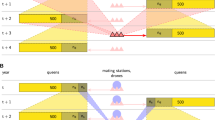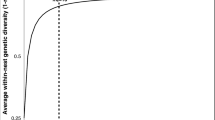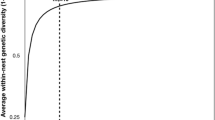Abstract
Darwin1 considered the dramatic differences in morphology and behaviour among sterile workers, the basis of colony division of labour in the social insects, to be a greater challenge to his theory of natural selection than the occurrence of worker sterility itself. Darwin's model for the evolution of these worker traits required: (1) heritable variation among workers within colonies; (2) variation in reproductive success among colonies due to different distributions of worker traits; and (3) changes in the distribution of worker traits within colonies due to colony-level selection. The role of genetics in this evolutionary process, unknown to Darwin, has still received little attention2,3. Calderone and Page4 recently demonstrated differences in the pollen-collecting behaviour of honey bees from two artificially selected strains5 co-fostered in wild-type colonies to be a consequence of genotypic differences between workers. These differences were caused by an artificial selection process analogous to that proposed by Darwin. Their study established a foundation for understanding genetic mechanisms underlying the evolution of division of labour but did not demonstrate a genetic basis for division of labour between related members of colonies, the essential element of the darwinian model. Here we report previously undescribed genetic differences in task specialization between related members of Apis mellifera colonies. These results, which support the first requirement of the darwinian model for the evolution of colony organisation, suggest that the genetic structure of an insect society plays a fundamental, and previously unrecognized, role in the division of labour.
Similar content being viewed by others
References
Darwin, C. The Origin of Species 250–257 (Mentor, New York, 1958).
Crozier, R. H. & Consul, P. C. Theor. pop. Biol. 10, 1–9 (1976).
Owen, R. E. Theor. pop. Biol. 29, 198–234 (1986).
Calderone, N. W. & Page, R. E. Behav. Ecol. Sociobiol. 22, 17–25 (1988).
Hellmich, R. L., Kulincević, J. M. & Rothenbuhler, W. C. J. Hered. 76, 155–158 (1985).
Seeley, T. D. Honeybee Ecology: A Study of Adaptation in Social Life 31–36 (Princeton University Press, Princeton, 1985).
Winston, M. L. The Biology of the Honey Bee 89–110 (Harvard University Press, Cambridge, 1987).
Taber, S. & Wendel, J. J. econ. Ent. 51, 786–789 (1958).
Adams, J., Rothman, E. D., Kerr, W. E. & Paulino, Z. L. Genetics 86, 563–596 (1977).
Page, R. E. & Metcalf, R. A. Am. Nat. 119, 263–281 (1982).
Laidlaw, H. H. & Page, R. E. Genetics 108, 985–997 (1984).
Contel, E. P. B., Mestriner, M. A. & Martins, E. Biochem. Genet. 15, 859–876 (1977).
Romero-Severson, J., Hogg, D. B., Kingsley, P. C. & Schwalbe, C. P. Ann. ent. Soc. Am. 79, 364–368 (1986).
Laidlaw, H. H. Instrumental Insemination of Honey Bee Queens (Dadant, Hamilton, 1977).
Visscher, P. K. Anim. Behav. 31, 1070–1076 (1983).
Moore, A. J., Breed, M. D. & Moore, M. J. Anim. Behav. 35, 1159–1167 (1987).
Seeley, T. D. Behav. Ecol. Sociobiol. 11, 287–293 (1982).
Page, R. E. & Breed, M. D. Trends Ecol. Evol. 2, 272–275 (1987).
Frumhorf, P. C. & Schneider, S. Anim. Behav. 35, 255–262 (1987).
Collins, A. M. J. Apicult. Res. 18, 285–291 (1979).
Robinson, G. E. J. comp. Physiol. A 160, 613–619 (1987).
Oster, G. F. & Wilson, E. O. Caste and Ecology in the Social Insects 151–155 (Princeton University Press, Princeton, 1978).
Wilson, E. O. in Experimental Behavioral Ecology and Sociobiology (eds Hölldobler, B. & Lindauer, M.) 307–325 (Sinauer, Sunderland, 1985).
Wilson, E. O. Science 228, 1489–1495 (1985).
Craig, R. Am. Nat. 116, 311–323 (1980).
Rinderer, T. E. & Collins, A. M. in Bee Genetics and Breeding (ed. Rinderer, T. E.) 155–177 (Academic, New York, 1986).
Winston, M. L. & Katz, S. J. Behav. Ecol. Sociobiol. 10, 125–129 (1982).
Free, J. B. Anim. Behav. 15, 134–144 (1967).
Jaycox, E. R. Ann. ent. Soc. Am. 63, 222–228 (1970).
Free, J. B., Ferguson, A. W. & Simpkins, J. R. Physiol. Ent. 9, 387–394 (1984).
Crozier, R. H. & Page, R. E. Behav. Ecol. Sociobiol. 18, 105–115 (1985).
Sherman, P. W., Seeley, T. D. & Reeve, H. K. Am. Nat. (in the press).
Hedrick, P. W. A. Rev. Ecol. Syst. 17, 535–566 (1986).
Blum, M. S. Proc. 8th int. Congr. IUSSI 54–59 (Wageningen, Holland, 1977).
Kaftanoglu, O. & Peng, Y. S. J. Apicult. Res. 19, 205–211 (1980).
Moritz, R. F. A. J. Apicult. Res. 24, 249–255 (1983).
Frumhoff, P. C. & Baker, J. Nature 333, 358–361 (1988).
Author information
Authors and Affiliations
Rights and permissions
About this article
Cite this article
Robinson, G., Page, R. Genetic determination of guarding and undertaking in honey-bee colonies. Nature 333, 356–358 (1988). https://doi.org/10.1038/333356a0
Received:
Accepted:
Issue Date:
DOI: https://doi.org/10.1038/333356a0
- Springer Nature Limited
This article is cited by
-
Corpse removal increases when honey bee colonies experience high Varroa destructor infestation
Insectes Sociaux (2020)
-
Effects of thymol on European honey bee hygienic behaviour
Apidologie (2019)
-
Within-colony genetic diversity differentially affects foraging, nest maintenance, and aggression in two species of harvester ants
Scientific Reports (2018)
-
The effects of disturbance threat on leaf-cutting ant colonies: a laboratory study
Insectes Sociaux (2017)
-
Variation in individual worker honey bee behavior shows hallmarks of personality
Behavioral Ecology and Sociobiology (2016)





